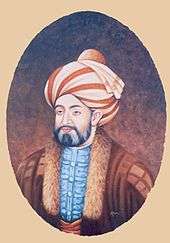Durrani
Durrani (Pashto: دراني) or Abdali (Pashto: ابدالي) is the name of a prominent Sarbani Pashtun tribal confederation in Afghanistan and Pakistan. They have been called Durrani since the beginning of the Durrani Empire in 1747.[1] Durrani are found throughout Afghanistan and Pakistan; although large concentrations are found in southern Afghanistan, they are also found to a lesser extent in east, west and central Afghanistan. Many Durranis are found in Khyber Pakhtunkhwa and Punjab provinces of Pakistan. The Durrani Pashtuns of the Afghan capital Kabul are usually bilingual in Pashto and Dari Persian. The ruling Sadduzai and Barakzai dynasties of Afghanistan were originally from the Durrani.
Descent of the Abdali/Durrani from Tareen
The Pashtuns believe that they are descended from the common ancestor Qais Abdur Rasheed.[2] In the case of the Tareen, they believe they are descended from his first son, Sarban, his son Sharkhbun, and his son Tareen, the founder of the tribe. Tareen had a number of sons, who correspond with the major divisions of the tribe.[3] One was named Bor Tareen, later renamed Abdali, who is the legendary founder of the Durrani tribe.[4] Thus, the Abdali/Durrani are in effect descended from the elder Tareen lineage.[5]
History


They were known in the past as Abdalis, from approximately the 7th century until the mid-18th century when Ahmad Shah Durrani was chosen as the new Emir and the Durrani Empire was established.[6] One of Ahmad Shah's first acts as Emir was to adopt the title padshah durr-i durran ('King, "pearl of the age").[7] He united the Pashtun tribes following a loya jirga in western Kandahar and changed his own name from Ahmad Shah Abdali to Ahmad Shah Durrani. Since that period, the kings of Afghanistan have been of Durrani extraction.
The origin of the Abdali is probably the Hephthalites though it is disputed.[8][9] The Zirak line begins with Sulaiman Zirak Khan. Zirak was father of Popalzai, Barakzai, and Alakozai.[10]
According to Hayat Khan's history of Afghanistan from their progenitor Bor Tarin, otherwise known as Abdal, are descended their two main divisions the Zirak and the Panjpai. The term Abdal, however, gradually superseded that of Bor Tareen and came into special prominence when Ahmad Shah Abdali Sadduzai commonly known as Durrani, began his career of conquest. The Achakzais are, in strictness, a branch of the Barakzai, but Ahmad Shah, Durrani himself an Abdal/Bor Tarin/Tareen, fearing the growing numbers of the Barakzai, separated them from the parent stock. Since then, their organization has remained distinct. It is still used, though sparingly, for the Achakzai, who have become localised in Toba and are regarded as a separate political unit from the rest of the Tarin/Tareens.

Branches or subtribes
The Panjpai branch are mainly found in the western Kandahar, Helmand and Farah area, and they include Alizai, Noorzai, Ishakzai or Sakzai, and Maku.
The literacy rate of the Durrani is the highest among all the Pashtun tribes and they are also considered the most liberal of the Pashtun tribes. The Durranis continue to live close to other people of Afghanistan and culturally overlap in many ways with the Tajiks whom they often share more cultural and socio-economic traits in comparison to the more tribal Pashtuns such as the Ghilji, which is the other major Pashtun tribe.
Durrani / Bor or Abdali Tareen
The Bor or Abdali Tareens inhabit Pakistan and Afghanistan comprise chiefly these sections:
The Bor/Abdali Tareens came to be known as 'Durranis' after Ahmad Shah Abdali became Emir of Afghanistan, and gradually this term superseded their original name.[11]
See also
References
- ↑ Encyclopædia Britannica, Durrani
- ↑ Olaf Caroe, 'The Pathans', 1957, np
- ↑ Ghulam Rasul Haider 'The Pashtuns- A monograph on tribal claims of their origins'. Peshawar" University of Peshawar Press, 1988, pp 11-13
- ↑ Haider, 14
- ↑ Haider, 13
- ↑ Treaty of Kalat between Balochistan and Afghanistan in 1758
- ↑ The Afghans (2002) By Willem Vogelsang. Page 229.
- ↑ http://www.diss.fu-berlin.de/diss/servlets/MCRFileNodeServlet/FUDISS_derivate_000000007165/01_Text.pdf
- ↑ http://www.diss.fu-berlin.de/diss/servlets/MCRFileNodeServlet/FUDISS_derivate_000000007165/01_Text.pdf?hosts=
- ↑ Life of the Amîr Dost Mohammed Khan, of Kabul: with his political ..., by Mohan Lal, Volume 1. Page 1-3.
- ↑ Nawab Muhammad Hyat Khan, "Hayat i Afghan" (Orig. in Persian 1865) trans. by H.B Priestley "Afghanistan and its Inhabitants", 1874; Reprint Lahore: Sang i Meel Press, 1981